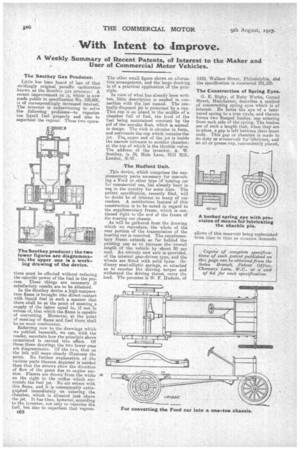With Intent to Improve.
Page 22

If you've noticed an error in this article please click here to report it so we can fix it.
A Weekly Summary of Recent Patents, of Interest to the Maker and User of Commercial Motor Vehicles.
The Seuthey Gas Producer.
Little has been heard of late of that strikingly original paraffin earburetter known as the Southey gas produce.: A recent improvement on it, which is now made public in specification No. 105,606, is of correspondingly increased interest. The inventor is endeavouring to solve the following problems—to vaporize. We liquid fuel properly and also to superheat the vapour. These two opera tions must be effected without reducing the calorific power of the fuel in the process. These things are necessary if satisfactory results are to be attained.
In the Southey device a high-temperature flame is brought into direct contact i
with liquid fuel n such a, manner that there shall be at the point of meeting ...a supply of the latter equal to, if not in excess of, that which the flame is capable of converting. Moreover, at the point of meeting of flame and fuel there shall be no more combustion.
Referring now to the drawings which we publish herewith, we can, with the reader, ascertain how the principle above enunciated is carried into effect. Of these three drawings the two lower ones ar diagrammatic. Of the two, that on the left will more clearly illustrate the point. No further explanation of the various parts thereon depicted is needed than that the arrows show the direction of flow of the gases due to engine suction. Flames are drawn from the wicks on the right to the orifice which surrounds the fuel jet. No air enters with this flame, and it is consequently extinguished immediately on entering the chamber, which is situated juat above the jet. It has time, however, according to the inventor, not only to vaporize the fuel, but also to superheat that vapour.
The other small figure shows an alternative arrangement, and the large drawing is of a practical application of the principle.
In view of what has already been written, little description is needed in connection with the, last named. The eentrally-disposed jet is protected by a cup. This cup is an island in the middle of a chamber full of fuel, the level of the fuel being maintained constant by the aid of the annular float, which is normal in design. The wick is circular in form, and surrounds the cup which contains the jet. Thç upper end of the jet is inside the narrow entrance to another chamber, at the top of which is the throttle valve. The address of the inventor, A. W. Southey, is 38, Hale Lane, Mill Hill, London, NW.
The Hudford Unit.
Tbis device, which comprises the supplementary parts necessary for converting a Ford or other type of touring car for commercial use, has already been in usq in the country for some time. The patent specification, recently filed, will no doubt be of interest to many of our readers. A meritorious feature of this construction is to he noted in regard to the supplementary frame, which is continued right to the end of the frame of the touring car chassis.
As will be gathered from the drawing which we reproduce, the whole of the rear portion of the transmission of the touring car is removed. The supplementary frame extends so far behind the existing one as to increase the overall length of the vehicle by about 50 per cent. An entirely new axle is provided, of the internal gear-driven type, and the wheels are fitted with solid tyres. Ordinary semi-elliptic springs, so attached as to counter the driving torque and withstand the driving thrust, carry the load. The patentee is W. F. Hudson, of
1410, Wallace Street, Philadelphia, ii-nd the specification is numbered 101,335.
The Construction of Spring Eyes.
G. E. Rigby, of Ruby Works, Cannel Street, Manchester, describes a method of constructing spring eyes which is of interest. He bores the eye of a laminated spring to a true circle, and therein forces two flanged bushes, one entering from each side of the spring. The bushes are of such a length that, when they are in place, a gap is left between their inner ends. This gap or chamber is made to do duty as wreservoir far lubricant, and an oil or grease cup, conveniently placed,
allows of this reservoir being replenished from time to time as occasion demands.
• Copies of complete specifications of each patent published on this page can be obtained from the Sales Branch, Patent Office,. Chancery Zane, W.C.. at a cost
of 45d. for each specification.






















